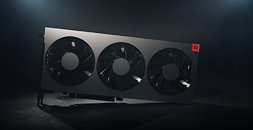Thursday, January 10th 2019

NVIDIA CEO Jensen Huang on Radeon VII: "Underwhelming (...) the Performance is Lousy"; "Freesync Doesn't Work"
PC World managed to get a hold of NVIDIA CEO Jensen Huang, picking his thoughts on AMD's recently announced Radeon VII. Skirting through the usual amicable, politically correct answers, Jensen made his thoughts clear on what the competition is offering to compete with NVIDIA's RTX 2000 series. The answer? Vega VII is an "underwhelming product", because "The performance is lousy and there's nothing new. [There's] no ray tracing, no AI. It's 7nm with HBM memory that barely keeps up with a 2080. And if we turn on DLSS we'll crush it. And if we turn on ray tracing we'll crush it." Not content on dissing the competition's product, Jensen Huang also quipped regarding AMD's presentation and product strategy, saying that "It's a weird launch, maybe they thought of it this morning."Of course, the real market penetration of the technologies Jensen Huang mentions is currently extremely low - only a handful of games support NVIDIA's forward-looking ray tracing technologies. That AMD chose to not significantly invest resources and die-space for what is essentially a stop-gap high-performance card to go against NVIDIA's RTX 2080 means its 7 nm 331 mm² GPU will compete against NVIDIA's 12 nm, 545 mm² die - if performance estimates are correct, of course.The next remarks came regarding AMD's FreeSync (essentially a name for VESA's Adaptive Sync), which NVIDIA finally decided to support on its GeForce graphics cards - something the company could have done outright, instead of deciding to go the proprietary, module-added, cost-increased route of G-Sync. While most see this as a sign that NVIDIA has seen a market slowdown for its G-Sync, added price-premium monitors and that they're just ceding to market demands, Huang sees it another way, saying that "We never competed. [FreeSync] was never proven to work. As you know, we invented the area of adaptive sync. The truth is most of the FreeSync monitors do not work. They do not even work with AMD's graphics cards." In the wake of these word from Jensen, it's hard to understand the overall silence from users that might have their FreeSync monitors not working.
Reportedly, NVIDIA only found 12 out of 400 FreeSync-supporting monitors to support their G-Sync technology automatically in the initial battery of tests, with most panels requiring a manual override to enable the technology. Huang promised that "We will test every single card against every single monitor against every single game and if it doesn't work, we will say it doesn't work. And if it does, we will let it work," adding a snarky punchline to this matter with an "We believe that you have to test it to promise that it works, and unsurprisingly most of them don't work." Fun times.
Source:
PC World
Reportedly, NVIDIA only found 12 out of 400 FreeSync-supporting monitors to support their G-Sync technology automatically in the initial battery of tests, with most panels requiring a manual override to enable the technology. Huang promised that "We will test every single card against every single monitor against every single game and if it doesn't work, we will say it doesn't work. And if it does, we will let it work," adding a snarky punchline to this matter with an "We believe that you have to test it to promise that it works, and unsurprisingly most of them don't work." Fun times.



270 Comments on NVIDIA CEO Jensen Huang on Radeon VII: "Underwhelming (...) the Performance is Lousy"; "Freesync Doesn't Work"
source: www.wepc.com/news/video-game-statistics/
@ time of posting it is at 143.09 and UP
While AMD is DOWN @ 19.33 ... I would rather own stock in a company that is worth $143 than a company with $19. just food for thought people.
NVIDIA Corporation
NASDAQ: NVDA
143.09 USD +0.51 (0.36%)
Jan 10, 1:56 PM EST ·
Advanced Micro Devices, Inc.
NASDAQ: AMD
19.33 USD −0.86 (4.26%)
Jan 10, 1:55 PM EST
... and the grapes are sour, said the fox when he saw that he could not reach them ...
or maybe:
... all this technology and these guys at amd crush us at compute, crush us at bandwidth with such an old technology and such small die size, a bit more than half of ours.
anyway pretty lame speech for a CEO, no diplomacy at all.
If it weren't for crypto, NVDA and AMD wouldn't be crapping their trousers at this point in time.
Imagine you'd have a 1080ti right now. Your only option is moving to a 2080ti at nearly double the MSRP for a pretty marginal performance win. Not really the best route. And if I look at myself; there is absolutely NO reason for me to ditch my 1080. Only a value-oriented performance upgrade would put me on that path and right now all I can move to is an 800 dollar 2080 to even make a dent.
Regardless, they're rumors. Just saying, don't be surprised if it happens.
Besides, this isn't about 2060, but the high end.
Strategically, I can't see any real good reasons why AMD releases this card. My best guess is they felt the need to get some attention in the market since they don't have anything else for a good while. This is similar to the "pointless" RX 590 released last year, released just to get another review cycle.
For the future, this doesn't look good. AMD just spent what might be the last "good" node shrink, and repurposed a GPU for the professional market, a GPU which is very expensive to make and taking up precious capacity on the 7nm node. If this was planned a long time ago, they would have made a GPU without full fp64 support and with GDDR6, then at least they could have sold it much cheaper. But with Vega 20 they are at a disadvantage, not only is the HBM2 more expensive, the die is too. And they even put 16GB on it, which is completely wasted for gaming. If they really wanted more than 8GB, they could have gone with 12GB, and at least made it a little cheaper.
VII is good, 2080 is no new content, no visual gains,... seriously?